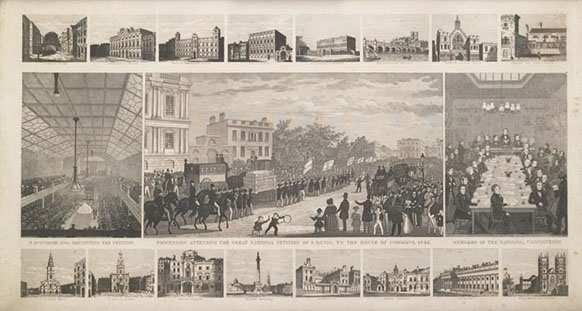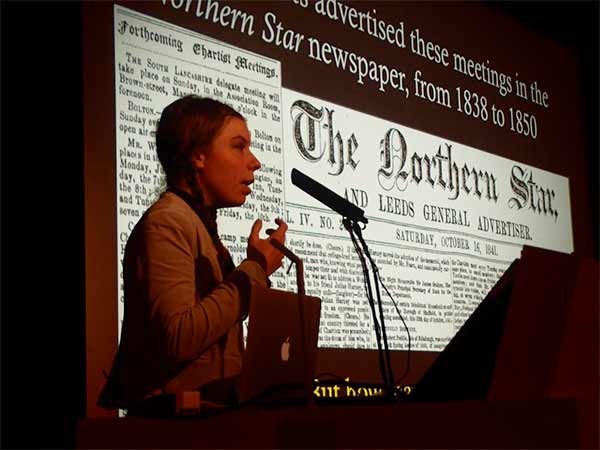
What price Chartist history?

A recent e-mail from an online book retailer quickly caught my attention. It advertised a ‘striking and rare contemporary print of the great Chartist National Petition being taken through the streets of London’. The scene, of course, is that of the procession accompanying the Second Great National Petition to the House of Commons in 1842 as depicted in the Northern Star. The largest image is of the 3,317,702 signatures – ‘the Chartist leviathan petition’ - being transported through the city. It was claimed by the Star that the petition was six miles long and weighed 6cwt; it required 30 strong men to carry it and, on reaching the House of Commons, the doors had to be removed for it to fit in to the Chamber.
This newspaper broadsheet (sized 25 inches by 15 inches) also records Thomas Slingsby Duncombe MP presenting the Petition, together with sixteen vignettes of places the procession passed on its journey to Westminster. Clearly visible are the central demands of the Chartists being carried aloft; the 50,000, as estimated by the Times, who joined the procession are shown holding unfurled banners, which demand ‘Reform’ and ‘More Pigs and Less Parsons’. These iconic images of the events of Monday 2 May 1842 were published in a free supplement to the Northern Star. The asking price in 2016: £350.
What perhaps this illustrates best of all, however, is the enduring legacy of the Northern Star.
The newspaper first appeared on 18th November 1837, and by 1850 had become vitally important in the propagation of radical ideas. In the process it made Feargus O’Connor a figure of national importance; it was soon to become one of the most successful newspapers of the early nineteenth century, with a regular circulation of 80,000 copies a week in 1839. O’Connor, together with printer and publisher, Josiah Hobson and former handloom weaver, William Hill, established a solid format of local news reporting, but with a commitment to publishing leading articles on larger political issues.
News reports initially tended to be a mixture of accounts of meetings and other political activities - those sent in by the secretaries of local Chartist associations. This potent radical amalgam helped the newspaper to portray regional issues within the wider context of a British political movement. Indeed, the same cocktail of local and national issues is also to be found in its advertisements. In addition, from December 1837 until 1851, the Northern Star issued thirty-four engravings but, as circulation began to fall in 1842, O’Connor decided to reduce the number of these images. As a result, between September 1841 and June 1846, only three were issued and, according to Malcolm Chase, these were more a reward for loyalty rather than a bid to boost circulation. This would seem to be the case with this supplement from 1842; it was issued as a free companion to the newspaper, fundamentally, to thank its readers for their patronage and on-going support.
The images from 1842 provide us with a snapshot of a moment in time, one of both hope and betrayal. London did not witness the same levels of protest found in the provinces during the summer of 1842, and, unlike the hysteria that surrounded 1848, the petition was handed in without violence or disorder. Yet, the rejection of Duncombe’s proposal - by 287 votes to 46 - that the petitioners be heard at the bar of the House of Commons, resulted in widespread class bitterness and resentment. The country was in the midst of a deep industrial depression and, as a consequence, many Chartists came to the conclusion that petitioning now served little purpose. They had read of the proceedings in Parliament; through reports in the Northern Star they quickly became aware that they had been defeated by enemies – enemies not only from without, but also from within. In 1841, O’Connor and the ‘little doctor’ of Ramsbottom, Peter McDouall, had suggested that Chartists might lend their support to the Tories against the ‘cruel Whigs’, and even listed the good points of ‘Sham Radical’ MPs. But in this case, and after showing initial caution, on the 21st May the Star’s editorial thundered out its contempt for the Establishment,
You have all heard how the petition has been treated; … sneered at; … mocked at by our bitterest enemies; … supported by our sham-friends … you have heard how Roebuck said the petition was drawn up by a cowardly demagogue; you have heard how Mr. O’Connell said he reparated himself from the petition in toto, you have heard how Macaulay and Bob Peel spurned the demand of millions; and thus, in consequence of the prayer of the petition being so unfairly treated, thousands have made their minds up not to petition again. Now I wish to put a fair question to every man, - “Did he expect better treatment from the misrepresentatives of the people?”
So, in evaluating the events of May 1842, do students of Chartism need to invest £350 in an original copy of this supplement from the Northern Star? I would argue that they do not. This item is catalogued under, ‘antiquarian and rare’, a commercial classification that conveys a certain measure of exclusivity, something that would have been abhorrent to most readers of the Northern Star in the 1840s. The newspaper’s primary function was to allow its readers to regard themselves as a single, coherent body of people. While permitting a diverse range of political opinions, they shared a common outlook, one that had no regard for origin, locality or social position. Chartism, for the majority of its supporters, was a march not only towards democracy, but also towards greater levels of inclusivity.
I would suggest that these principles have today been realised in the means by which important historical resources, such as the Northern Star, can now be read and scrutinised. In essence, the digitalisation of source material has rapidly achieved a democratisation of history: that desire for inclusivity has largely been achieved. Before the Internet was available for the majority, access to historical records remained very much the reserve of the academic and the full-time researcher.
Today, it is possible to use a site such as British Newspaper Archive to examine the Northern Star with new eyes, to explore its pages without being overtly influenced by the views of historians. Moreover, reading a copy of the Star from 1842 has that special capacity to transport the reader into another time, providing the facility to briefly dwell in a world of the present and not of the past.

I say, however – and without apology, that we still need historians to help us to interpret these events; we need to consider, for example, Chase’s assertion that ‘the year 1842 was a point at which history failed to turn’. And yet, the digital revolution has significantly changed the way in which historians now work too, an excellent example of which is to be found in the work of Dr. Katrina Navickas of the University of Hertfordshire. *
Working with the digital team at the British Library she has developed a new research tool called Political Meetings Mapper. This allows notices of meetings to be extracted and plotted onto layers of historical maps. Meetings listed in The Northern Star, therefore, can be used to create a new landscape of spatial patterns, shedding light on many questions that have previously gone unanswered. Many readers will recognise that such an approach parallels work done here in Wales, in both the Cynefin Project and Trails to Trials: Chartism in Gwent.
What price then a piece of Chartist history? Increasingly, and wonderfully, this is an opportunity that is rapidly becoming accessible to all members of society. I am confident that this is something that the Chartist Movement of the 1840s and the loyal readers of the Northern Star, in particular, would have heartily applauded.
Ray Stroud,
September 2016
* Dr. Navickas will be speaking on this topic at the 10th Chartist Convention at John Frost School, Newport on 5 November.
DON’T FORGET TO BOOK YOUR PLACE at the 10th Annual Newport CHARTIST CONVENTION 2016
Saturday 5 November 09.30 – 16.30
Venue: JOHN FROST SCHOOL, Lighthouse Road, Newport, NP10 8YD
For programme details, location map and to book your place GO TO https://chartist-convention-2016.eventbrite.co.uk
Dr Katrina Navickas









